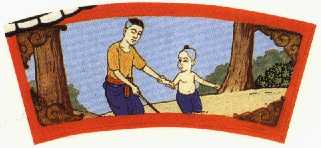 1. Avijja (Ignorance):
This first link is illustrated by a
man who does not know where he is
going as he cannot see anything and
cannot do anything right. He is
totally deluded because of Ignorance.
It is the mind full of delusion and
wrong views about matter and mind
(Rupa-Nama). As a result, it
keeps on grasping and clinging to the
aggregates of form, sound, smell,
taste and mind objects, without any
investigation into the separation of
each element and aggregate from one
another. The mind will eventually
attach to the belief that there is a
Self, a solid being which will not
decay or dissolve. There is no
ability to separate body from mind
and no knowledge of the cause of
rising and falling of consciousness.
This delusion about the idea of Self
in opposition to others stems from a
lack of insight into reality. In fact
these phenomena are consisted only of
the 4 elements of earth, water, fire
and wind, plus intentional activities
and consciousness. Therefore Avijja
stands for a deluded human being
(Moha) who is full of ignorance and
does not realise the Truth. So he is
portrayed by a blind person. 1. Avijja (Ignorance):
This first link is illustrated by a
man who does not know where he is
going as he cannot see anything and
cannot do anything right. He is
totally deluded because of Ignorance.
It is the mind full of delusion and
wrong views about matter and mind
(Rupa-Nama). As a result, it
keeps on grasping and clinging to the
aggregates of form, sound, smell,
taste and mind objects, without any
investigation into the separation of
each element and aggregate from one
another. The mind will eventually
attach to the belief that there is a
Self, a solid being which will not
decay or dissolve. There is no
ability to separate body from mind
and no knowledge of the cause of
rising and falling of consciousness.
This delusion about the idea of Self
in opposition to others stems from a
lack of insight into reality. In fact
these phenomena are consisted only of
the 4 elements of earth, water, fire
and wind, plus intentional activities
and consciousness. Therefore Avijja
stands for a deluded human being
(Moha) who is full of ignorance and
does not realise the Truth. So he is
portrayed by a blind person. |
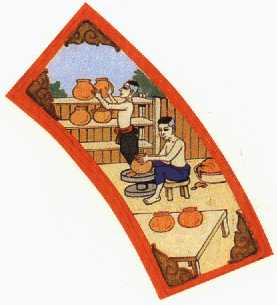 2. Sankhara (Volitional
activities) is represented by a
potter shaping pots on his wheel. He
is trying to make something into a
form from the material already
available. This shows the way Form,
Taste, Smell, Sound, tangible
objects, and mind-objects are created
through mind contact. It is the mind
which is full of impulses, emotions
and various thoughts every time there
is a contact between one of the six
senses and an object. Like (merit)
and dislike (demerit) will
automatically follow. There will also
be neutral feeling
(Anechabhisankhara) which is neither
merit nor demerit. So Sankhara is the
cause of impulses and emotions. 2. Sankhara (Volitional
activities) is represented by a
potter shaping pots on his wheel. He
is trying to make something into a
form from the material already
available. This shows the way Form,
Taste, Smell, Sound, tangible
objects, and mind-objects are created
through mind contact. It is the mind
which is full of impulses, emotions
and various thoughts every time there
is a contact between one of the six
senses and an object. Like (merit)
and dislike (demerit) will
automatically follow. There will also
be neutral feeling
(Anechabhisankhara) which is neither
merit nor demerit. So Sankhara is the
cause of impulses and emotions. |
3. Vinnana (Consciousness):
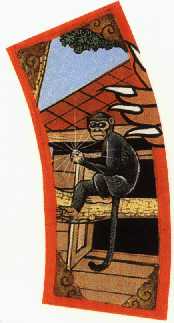 A monkey holding a crystal
depicts restless mind in which the
rising and falling of consciousness
takes place all the time. The crystal
represents virtue. When the crystal
is clear, the virtue is there; but
when it is dull, there is none. A
house represents the sense spheres
(Ayatana). Awareness must be
developed every time there is contact
between one of the 6 senses and an
object. A monkey holding a crystal
depicts restless mind in which the
rising and falling of consciousness
takes place all the time. The crystal
represents virtue. When the crystal
is clear, the virtue is there; but
when it is dull, there is none. A
house represents the sense spheres
(Ayatana). Awareness must be
developed every time there is contact
between one of the 6 senses and an
object. |
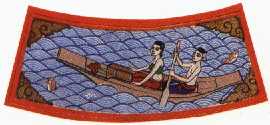 4. Rupa-Nama (Matter and Mind)
is portrayed by a man and a woman on
a boat. (Matter is depicted by the
boat and Mind by the passengers). The
physical form is represented by the
boat and Consciousness is represented
by the people. Though the two
phenomena are different, they have to
depend on each other. 4. Rupa-Nama (Matter and Mind)
is portrayed by a man and a woman on
a boat. (Matter is depicted by the
boat and Mind by the passengers). The
physical form is represented by the
boat and Consciousness is represented
by the people. Though the two
phenomena are different, they have to
depend on each other. |
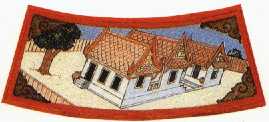 5. Salayatana (6
Sense Organs) is depicted by the
image of an empty house with doors
and windows which symbolise the six
senses. The house stands for the
body, the doors for the mind, and the
windows for the eyes, ears, nose and
tongue. 5. Salayatana (6
Sense Organs) is depicted by the
image of an empty house with doors
and windows which symbolise the six
senses. The house stands for the
body, the doors for the mind, and the
windows for the eyes, ears, nose and
tongue. |
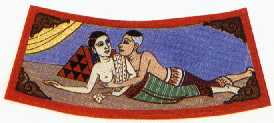 6. Phassa (Contact):
A couple embracing represents the
contact from which consciousness of
being male and female arises. As a
result, impulses and emotions are
produced and defilements, craving,
like, dislike and imbalance
follow. 6. Phassa (Contact):
A couple embracing represents the
contact from which consciousness of
being male and female arises. As a
result, impulses and emotions are
produced and defilements, craving,
like, dislike and imbalance
follow. |
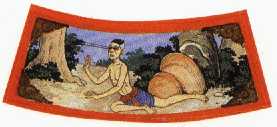 7. Vedana (Sensation)
is reflected by a man with an arrow
sunk deep in his eyes and is in great
pain. It indicates the strong feeling
which our sensory experience, driven
by impulses, evokes whether it is
pleasure or pain. 7. Vedana (Sensation)
is reflected by a man with an arrow
sunk deep in his eyes and is in great
pain. It indicates the strong feeling
which our sensory experience, driven
by impulses, evokes whether it is
pleasure or pain. |
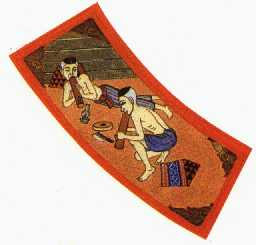 8. Tanha (Craving)
is depicted in the image of a man
smoking opium. He is an addict who
always craves for more and more of
the drug. Having no contentment, he
cannot have enough of it. Craving
cannot be fulfilled. It is the mind
which causes impulses and
emotions. 8. Tanha (Craving)
is depicted in the image of a man
smoking opium. He is an addict who
always craves for more and more of
the drug. Having no contentment, he
cannot have enough of it. Craving
cannot be fulfilled. It is the mind
which causes impulses and
emotions. |
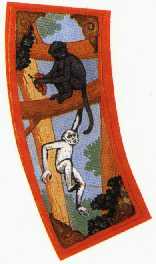 9. Upadana (Grasping)
is represented by a monkey plucking
fruits from a tree. Grasping them
brings about attachment when he is
under the illusion that the fruits
belong to him. 9. Upadana (Grasping)
is represented by a monkey plucking
fruits from a tree. Grasping them
brings about attachment when he is
under the illusion that the fruits
belong to him. |
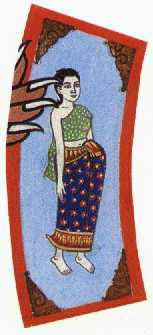 10. Bhava (Becoming):
A pregnant woman indicates the embryo
in her womb. Becoming signifies the
plane of existence which corresponds
to volitions; it signifies the
existence of body and mind. There is
attachment to the concept of ‘my
place’, ‘our place’, ‘our group’,
‘our nation’, Self, love and hate.
Intentional activities continually
produce impulses and emotions with
the rising and falling of
consciousness. 10. Bhava (Becoming):
A pregnant woman indicates the embryo
in her womb. Becoming signifies the
plane of existence which corresponds
to volitions; it signifies the
existence of body and mind. There is
attachment to the concept of ‘my
place’, ‘our place’, ‘our group’,
‘our nation’, Self, love and hate.
Intentional activities continually
produce impulses and emotions with
the rising and falling of
consciousness. |
 11. Jati (Birth):
A woman giving birth to a baby
reflects rebirth into different kinds
of being such as female, male, animal
or other. It is birth into the 3
planes of existence. It is the mind
in which volitions cause impulses and
emotions. Concurrently, consciousness
keeps on rising and falling, followed
by love and hate. Birth and existence
take place continuously without
end. 11. Jati (Birth):
A woman giving birth to a baby
reflects rebirth into different kinds
of being such as female, male, animal
or other. It is birth into the 3
planes of existence. It is the mind
in which volitions cause impulses and
emotions. Concurrently, consciousness
keeps on rising and falling, followed
by love and hate. Birth and existence
take place continuously without
end. |
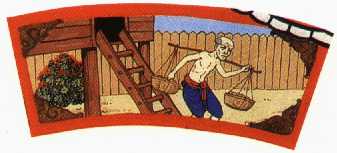 12. Jara-Marana(Old
age and Death): This last link is
personified by a man leaving home,
his belongings carried in a basket on
a pole over his shoulder. This
indicates leaving the body behind as
there will be no return. The only
things that can be taken are merit
and demerit. The house, representing
property, will have to be left
behind. He will be accompanied by
sorrow, lamentation, pain, grief,
despair, disappointment, and mourning
at the separation from loved ones.
The greatest suffering in life comes
at death, which is Marana. Marana is
the mind which has died from good,
evil, this world, the next world,
merit and demerit. At every moment
the mind is born and dies.
Consciousness, after rising, must
fall. This process is called, “the
present death.” The death of the (5)
aggregates is called, “the death in
the 3 planes of existence.” The
ending of the process of rising and
falling of consciousness is called,
“the death of the present moment” –
each moment is always dying as mind
rises and falls. (Nibbana). 12. Jara-Marana(Old
age and Death): This last link is
personified by a man leaving home,
his belongings carried in a basket on
a pole over his shoulder. This
indicates leaving the body behind as
there will be no return. The only
things that can be taken are merit
and demerit. The house, representing
property, will have to be left
behind. He will be accompanied by
sorrow, lamentation, pain, grief,
despair, disappointment, and mourning
at the separation from loved ones.
The greatest suffering in life comes
at death, which is Marana. Marana is
the mind which has died from good,
evil, this world, the next world,
merit and demerit. At every moment
the mind is born and dies.
Consciousness, after rising, must
fall. This process is called, “the
present death.” The death of the (5)
aggregates is called, “the death in
the 3 planes of existence.” The
ending of the process of rising and
falling of consciousness is called,
“the death of the present moment” –
each moment is always dying as mind
rises and falls. (Nibbana). |
|